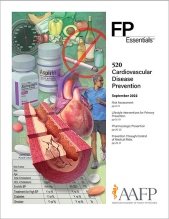
This clinical content conforms to AAFP criteria for CME.
As part of the approach to primary prevention of cardiovascular disease (CVD), adults should have their CVD risk estimated using a population-appropriate risk equation. In the United States, the atherosclerotic cardiovascular disease (ASCVD) pooled cohort equations are recommended by the American College of Cardiology/American Heart Association (ACC/AHA) to estimate risk in patients ages 40 to 79 years. A 10-year ASCVD risk estimate of 20% or higher is considered high, and patients having this level of risk should be offered and counseled to receive statin therapy. A 10-year risk estimate of 7.5% to less than 20% is considered intermediate, and clinicians should discuss the potential benefits of statin therapy for primary prevention in the context of the patient’s preferences and values. In some situations, use of CVD risk enhancers, particularly coronary artery calcium assessed by computed tomography, may help inform the clinician-patient discussion. All patients should be counseled about healthy lifestyle modifications to reduce CVD risk. The AHA’s Life’s Simple 7 defines ideal cardiovascular health as no tobacco use; ideal blood pressure, blood glucose, and cholesterol levels; adequate physical activity; weight management; and healthy diet. An 8th component (sleep) was very recently added and 4 of the original components have been updated. These metrics provide goals that can drive efforts toward primordial prevention (ie, keeping risk factors themselves from developing).
Subscribe
From $350- Immediate, unlimited access to FP Essentials content
- 60 CME credits/year
- AAFP app access
- Print delivery available
Edition Access
$44- Immediate, unlimited access to this edition's content
- 5 CME credits
- AAFP app access
- Print delivery available
